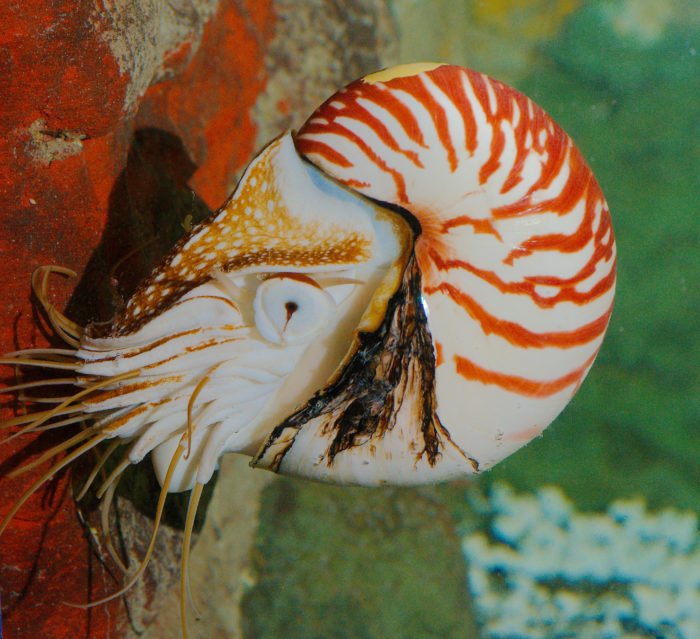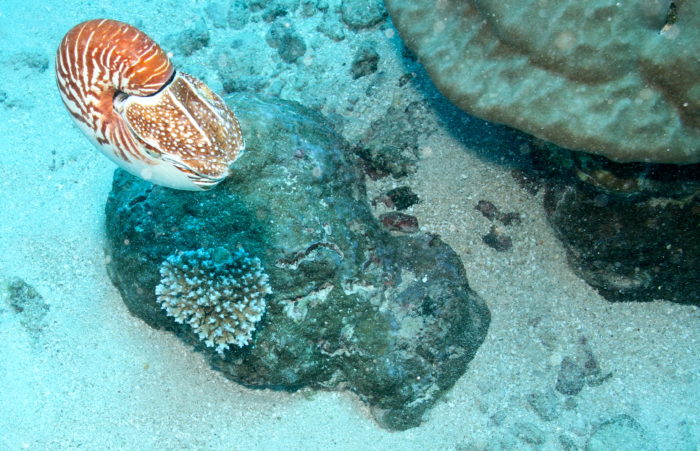
Sea Wonder: Chambered Nautilus

A close-up of a chambered nautilus. Photo credit: Josh More
The chambered nautilus (Nautilus pompilius) is a cephalopod, related to cuttlefish, squid, and octopus, that has captivated the human imagination for centuries. The species has existed for millions of years, surviving radical changes in environmental conditions without much evolutionary change of their own, making them what some call “living fossils”. In the modern world, we’ve honored nautiluses by naming things after them, two notable examples of which are the USS Nautilus, the world’s first nuclear-powered submarine launched in 1954, and a line of exercise equipment called the Nautilus™, named for the pulleys that are modeled after the cross-sections of a nautilus shell.
DESCRIPTION
Nautiluses are cephalopods, invertebrates characterized by a basic anatomy consisting of a head, a body, and a “foot”, along with at least eight arms that extend from the base of their heads. The chambered nautilus has ninety tentacles protruding from its shell, none of which have suckers on them. However, the tentacles do have grooves and ridges that help the nautilus grip objects and prey. It has two eyes, one on each side of its body, which are quite primitive and simple compared to those of other cephalopods.
Nautiluses live in spiralized shells with white coloration on its bottom side and darker orange stripes that form a spiral or whorl along the top and sides. Unlike other shelled animals that find new shelter as they grow, nautiluses grow into their shells; as their soft bodies grow, they extend forward into the chambered shell and older chambers they previously occupied become sealed off. Nautiluses can completely withdraw their bodies into their shells and close the opening with a leathery organ called the hood.
In addition to serving as protection for its body and organs, the nautilus’ shell contains a complex system of chambers that help the animal move gas around to control its buoyancy in the water column. This is the same way submarines fill and empty dive tanks to stay level or neutrally buoyant in the water. A specialized, tubular organ called the siphon, located at the center of its body and between its tentacles, allows the animal to move water and gasses in and out of its body cavity and regulate buoyancy. The nautilus can also use its siphon to forcefully push water out of its body cavity and propel the animal forward like jet propulsion. The way the siphon directs the water stream determines the direction of movement.
DIET & HABITAT
Chambered nautiluses are carnivores that use both active hunting and passive scavenging strategies to forage. They generally search for crustaceans or invertebrates living in the water column or on the ocean floor. To find their food, chemosensory organs on their tentacles detect what we would consider scents from their prey. They can use their siphons to uncover critters hiding in the sediment, and, since these nautiluses don’t have sucker organs on their tentacles, they capture prey by wrapping several tentacles around their target and pull it toward their mouth. The nautilus’ natural predators include octopus, sharks, triggerfish, and grouper.
The chambered nautilus primarily lives on or near reefs in the western Pacific Ocean and in parts of the coastal Indian Ocean, including near National Marine Sanctuary of American Samoa and Rose Atoll Marine National Monument. The species is pelagic, meaning it lives in the water column, which is unique for shelled invertebrates, which tend to live on the seafloor or attached to a reef. They spend most of their time hovering in the water column along the reef dangling their tentacles, migrating vertically at sundown to forage, returning to the depths at sunrise. Throughout their range, they live in smaller, isolated populations and don’t seem to travel too far from their reefs.
LIFE HISTORY
The life history of a chambered nautilus makes the species highly vulnerable to changes in the environment. Traits that contribute include low reproductive rates, slow individual growth, and delayed sexual maturity. Chambered nautiluses are longer-lived unlike most other cephalopods and can reproduce more than once in their lifetimes – squids and other cephalopods often shortly die after reproduction. Scientists believe the higher range of a nautilus’ lifespan is upward of 20 years. Other than reproduction, nautiluses are not highly social animals and spend much of their time alone.
Chambered nautilus larvae hatch from eggs after about a year of incubation. The species reproduces via internal fertilization where males use specialized tentacles used for passing sperm cells on to females. Once fertilized, females will lay several eggs, one at a time, attaching the membrane covered eggs to a hard surface with one of her tentacles. Nautilus hatchlings are the largest of all cephalopods but are not fully grown until they reach their full body size between around 10 and 15 years old.
THREATS & CONSERVATION
The primary threats to nautiluses include reef degradation and destruction and hunting driven by international demand for their beautiful shells, which are used in art, furniture, jewelry, and other goods. Given slow growth, low reproductive rates, and low mobility, chambered nautiluses are particularly vulnerable to overfishing, especially when other pressures exist. In 2018, NOAA Fisheries listed the chambered nautilus as a threatened species under the Endangered Species Act, and in 2016, at the 17th Conference of the Parties of CITES, all nautilus species were listed on Appendix II of CITES, which means they are at risk of extinction unless trade is carefully regulated.

A chambered nautilus swimming in American Samoa National Marine Sanctuary. Photo credit: NOAA
